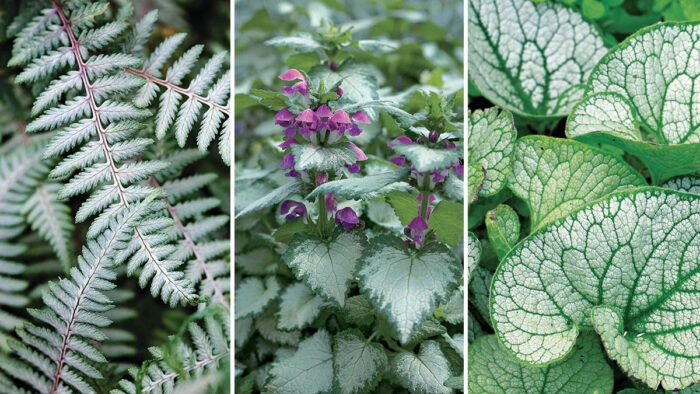
Silver foliage is a useful tool in garden design, as it provides subtle variety that easily pairs with almost all other foliage and flower colors. Unlike attention-getting chartreuse hostas or in-your-face burnt orange heucheras, silver-foliaged plants provide a soft glow in the subdued light of a shade garden. They don’t shout for attention; they gently pull you in.
Truth be told, there are few plants that have silver leaves. What is typically referred to as “silver” can range from leaves with fine white hairs, to foliage in shades of gray, to the occasional foliage with a true metallic silver shimmer. Add to that variegation where white combines with gray-green, resulting in a muted “silver” foliage (especially when played against the dark green leaves of a neighboring plant), and the result is a wide range of foliage colors and patterns that are collectively referred to as “silver.” In all honesty, this article should be called “Shade Perennials With Foliage That Is Silver or Grayish-Silver or White-Variegation-That-Looks-Silverish-From-a-Distance,” but I was pretty sure that the editors wouldn’t go for it.
Below are a few of my favorite silver-foliaged plants. They have all passed the durability test, as I have gotten to the point where I am less accommodating to plants with a frail constitution or that require gardening gymnastics to keep them alive. These are all winners that deserve a place in your shade garden. See three ways to use silver to brighten up your shade garden.
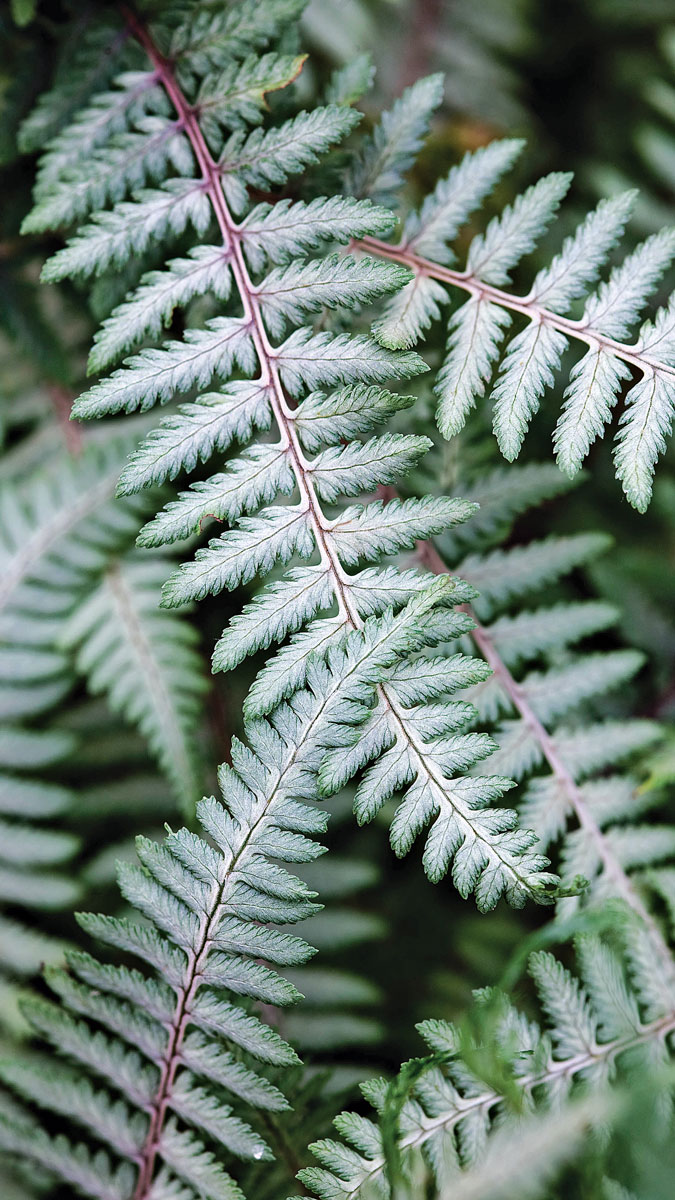
‘Branford Beauty’ painted fern makes an elegant focal point
Name: Athyrium ‘Branford Beauty’
Zones: 4–8
Size: 18 to 24 inches tall and 24 to 30 inches wide
Conditions: Partial to full shade; moist, well-drained soil
Native range: Garden hybrid
‘Branford Beauty’ painted fern is a remarkable hybrid between lady fern (Athyrium filix-femina, Zones 4–8) and Japanese painted fern (Athyrium niponicum var. pictum, Zones 4–9). With its elegant, upright but arching-just-enough fronds, it can be used as a focal point or planted in drifts. The fronds are soft gray with a silver-gray highlight running down the center of each pinnule and ending at the burgundy stems. As compared to the more commonly available ‘Ghost’ painted fern (Athyrium ‘Ghost’, Zones 4–9), another hybrid between lady fern and Japanese painted fern, I find ‘Branford Beauty’ more vigorous and prefer its arching form over the more upright foliage of ‘Ghost’.
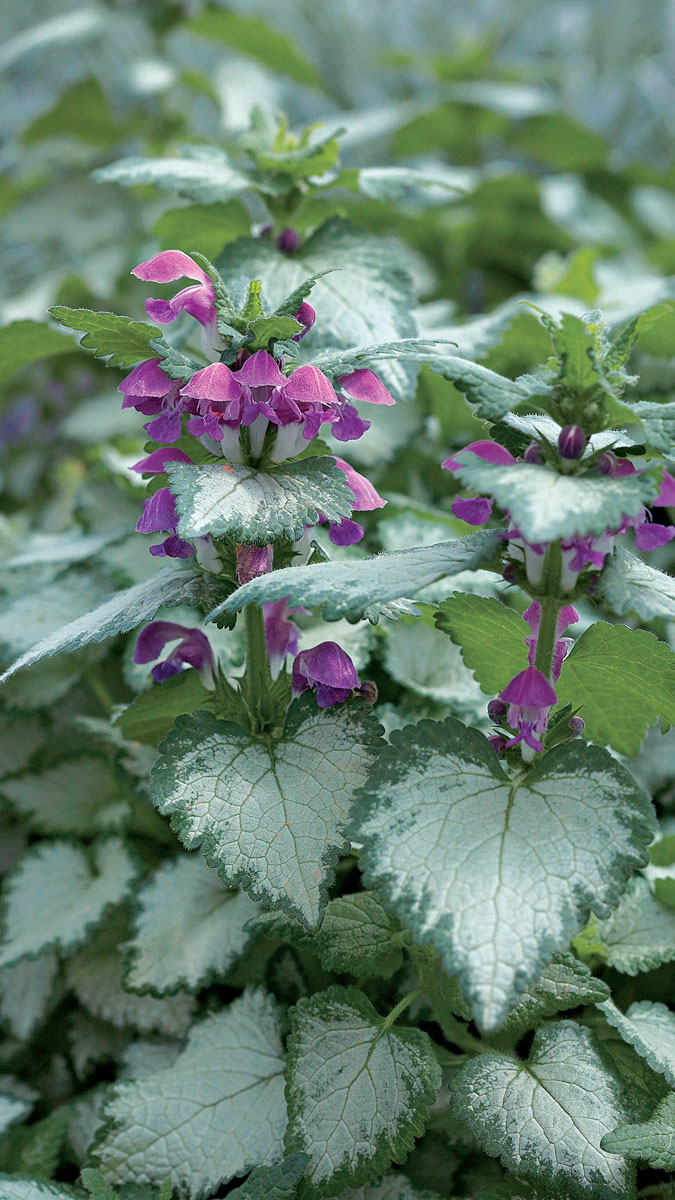
‘Purple Dragon’ lamium covers the ground all season long
Name: Lamium maculatum ‘Purple Dragon’
Zones: 3–8
Size: 6 to 8 inches tall and spreading indefinitely
Conditions: Partial to full shade; moist, well-drained soil
Native range: Europe to Western Asia
Lamium is an easily grown, shade-loving ground cover. Its fast growth and rambling habit make for just the right amount of mingling as it emerges around and through its neighbors. ‘Purple Dragon’ is an especially striking and vigorous cultivar with almost-silver leaves and purplish-pink blossoms that stand in contrast above the foliage. Whereas some lamium cultivars die out, forming bare patches, ‘Purple Dragon’ forms a thick mat of persistent foliage. If purple flowers don’t fit your color scheme, other varieties of lamium might. ‘White Nancy’ is a nice cultivar with white flowers and silver leaves edged in green, and ‘Shell Pink’ is a strong grower with pink flowers held above green foliage with a broad silver stripe down the center. ‘Purple Dragon’ will spread indefinitely as the stems root in the ground and spread out. Compacted and wet soil, especially in winter, can lead to crown rot.
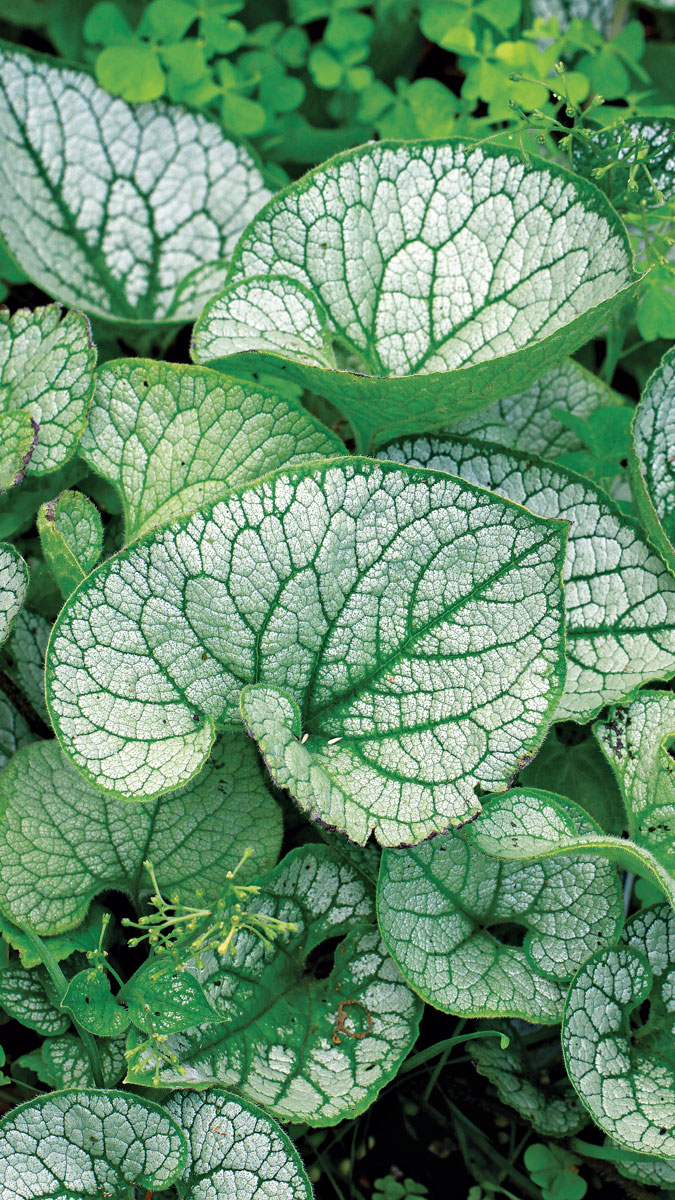
‘Sea Heart’ brunnera is tops for handling heat and humidity
Name: Brunnera macrophylla ‘Sea Heart’
Zones: 3–8
Size: 12 inches tall and 18 to 24 inches wide
Conditions: Partial shade; moist, well-drained soil
Native range: Eastern Europe to Western Asia
For many years, the cultivar ‘Jack Frost’ was the standard for silver-foliaged brunnera. It was an immediate sensation after being introduced in 2000, and in 2012 it was named Perennial Plant of the Year by the Perennial Plant Association. ‘Jack Frost’ is indeed a good plant, but I think it has been surpassed by the cultivar ‘Sea Heart’. While it is much like ‘Jack Frost’—with silver, heart-shaped foliage dramatically patterned with vivid green veining and sprays of blue flowers in spring—‘Sea Heart’ is a more vigorous plant, with bigger and brighter foliage that stands up to heat and humidity. Everything about this plant ups the game over its predecessor. While ‘Jack Frost’ might be more readily available, I urge you to seek out ‘Sea Heart’, as it will be worth the time and effort. If you are looking for even more silver in the leaves, consider the cultivar ‘Silver Heart’, whose foliage has less green veining and sparkles from spring to fall. Or for just a touch of muted silver, try ‘Emerald Mist’, whose dark green leaves are sprinkled with silver blotches along the perimeter. Whichever brunnera you choose, locate it in partial sun, and plant it in rich, well-drained soil that is consistently moist. Remove the spent flower stalks to the ground, as they distract from the large heart-shaped leaves.
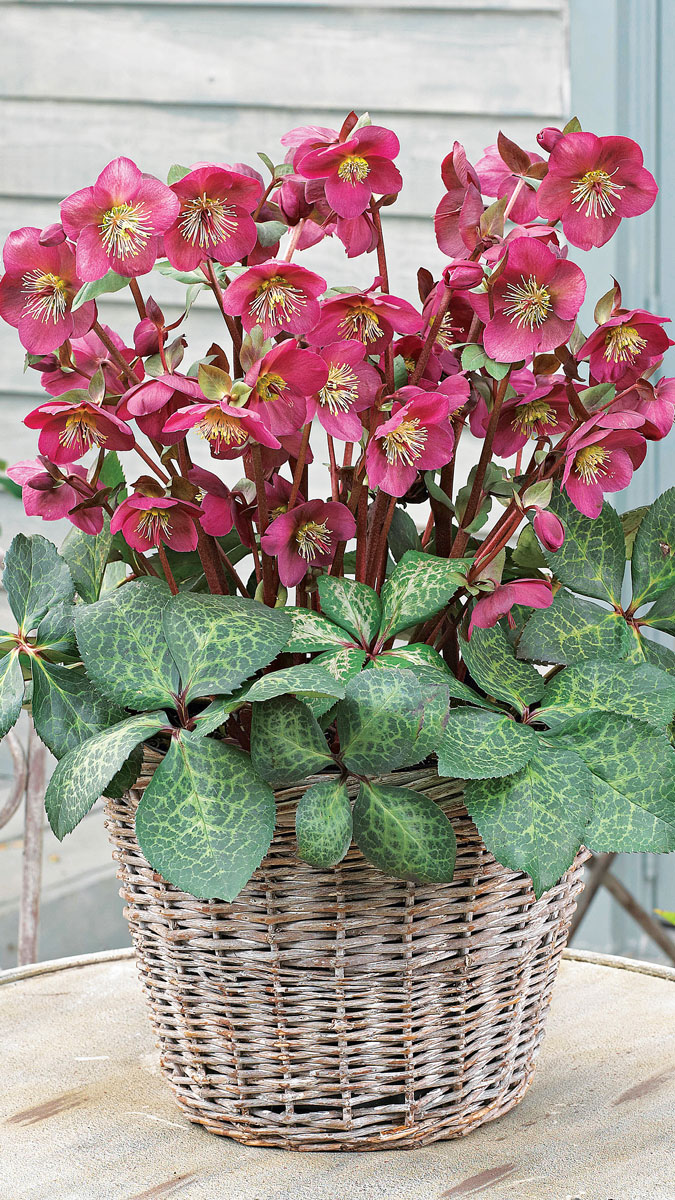
‘Anna’s Red’ hellebore has blooms as glorious as the leaves
Name: Helleborus × iburgensis ‘Anna’s Red’
Zones: 5–8
Size: 15 inches tall and 2 feet wide
Conditions: Partial to full shade; average to moist, well-drained soil
Native range: Garden hybrid
A number of new hellebores reach the market each year. Interesting foliage and more colorful blossoms are the hallmarks of these new hybrids, and ‘Anna’s Red’ hellebore is a wonderful example of this breeding. The spring foliage emerges a glossy dark green with bright green veining overlaid with a pink marbling that slowly turns creamy silver. While the silver pattern disappears as summer progresses, the bright green veining remains. Outward-facing purple-red blossoms in early spring add to the beautiful foliage. Slow to establish, hellebores are long-lived and do not require dividing, so plant them where they can remain undisturbed. They look great underplanted with wood anemone (Anemone nemorosa, Zones 5–8) and next to other spring bloomers such as epimedium (Epimedium spp. and cvs., Zones 4–9) and Japanese primrose (Primula sieboldii, Zones 4–7). While hellebores will survive in the shade, they grow better in dappled sunlight or, better yet, with a bit of direct sun.

Chinese wild ginger brings the drama
Name: Asarum splendens
Zones: 5–9
Size: 6 to 8 inches tall and 12 to 18 inches wide
Conditions: Partial to full shade; moist, well-drained soil
Native range: China
Chinese wild ginger is a vigorous ground cover that readily spreads by underground rhizomes, eventually covering a large area with a thick mat of foliage. Its incredible heart-shaped foliage is dark green, dramatically mottled with silver spots and bands. Add to that unusual purple-brown blossoms that hover at ground level to attract insects for pollination, and you have a winner. Because of the foliage coloration, I find that it works nicely when planted around taller silver-foliaged plants such as ferns, where the shiny green ginger foliage sets off the muted silver fern foliage and silver spotting ties the two together. Chinese wild ginger prefers well-draining organic soil and can succumb to root rot if planted in poorly drained soil that stays too wet. In its northern range, it benefits from a thick winter mulch to protect it.

‘Trevi Fountain’ has the best foliage of all pulmonarias
Name: Pulmonaria ‘Trevi Fountain’
Zones: 4–9
Size: 9 to 12 inches tall and 12 to 18 inches wide
Conditions: Partial shade; average to moist, well-drained soil
Native range: Garden hybrid
Pulmonaria are clump-forming perennials whose leaves range from solid green to spotted or blotched with silver. In some cultivars the silver spotting is so dense that the leaves appear almost silver-white. According to Tony Avent of Plant Delights Nursery, the spotting is caused by air pockets in the leaves that mask the chlorophyll and serve to cool the lower surface of the leaves. With a lot of winning cultivars on the market, one of my favorites is ‘Trevi Fountain’. It has beautiful foliage with all the right stuff: just enough silver spotting to create a nice pattern, and early spring blossoms in a lovely shade of blue. Pulmonaria blossoms range from pink to blue to purple, but with silver foliage, I prefer blue blossoms. After they start to fade, remove the spent flower stems so that the flush of larger variegated foliage that emerges after flowering can take center stage. If you neglect to deadhead, you will likely end up with a smattering of seedlings around the parent plant. While they are easily removed, you might consider letting a few mature to see what the offspring look like. In my own garden, one of my favorite pulmonarias is a seedling that showed up after I failed to thoroughly deadhead my plants. Two additional cultivars worth consideration are ‘Samurai’, with almost completely silver, spear-shaped leaves and cobalt blue flowers, and ‘Raspberry Splash’, which, as the name implies, has silver-splotched leaves and raspberry blossoms. With any pulmonaria, too much sun or excessively dry soil can lead to browning on the edges of the foliage. Some cultivars are prone to powdery mildew, but ‘Trevi Fountain’ is definitely not one of them.
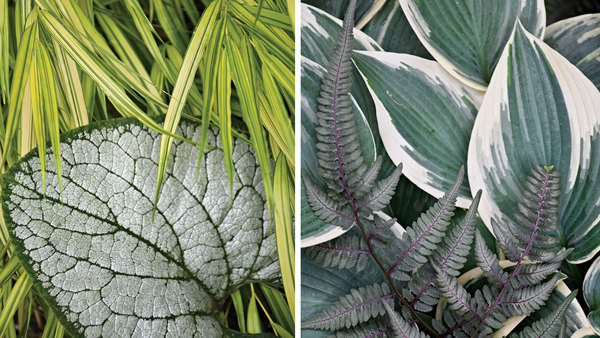 |
More on silver in the shade garden
“In the shade, where foliage often trumps blossoms, it is important to take into account the size, shape, color, and texture of leaves and how they relate to each other. Silver foliage is an exciting option to add to the mix. In general, strive to provide enough interest in colors and textures to avoid boredom and enough restraint to avoid visual chaos.” See three ways to use silver to brighten up your shade garden. |

Plant ‘Silk Tassel’ Japanese sedge up close to admire its foliage
Name: Carex morrowii ‘Silk Tassel’
Zones: 5–9
Size: 12 to 15 inches tall and 18 inches wide
Conditions: Partial shade; moist to wet soil
Native range: Japan
Native to the alpine areas of Japan, Japanese sedge forms a dense mound of very fine grass blades. ‘Silk Tassel’ is a special form, with a small silvery-white stripe down the center of each leaf that turns the entire mound of foliage into a delicate pile of airy silver. I like to use ‘Silk Tassel’ along a garden path or the edge of the garden where you can closely admire its delicate foliage. ‘Silk Tassel’ is especially dramatic when located near large-leaved plants—hostas, for example—as the contrast plays up its delicate nature. While this plant is evergreen in Zones 8–9, in colder regions its foliage should be cut down in early spring.
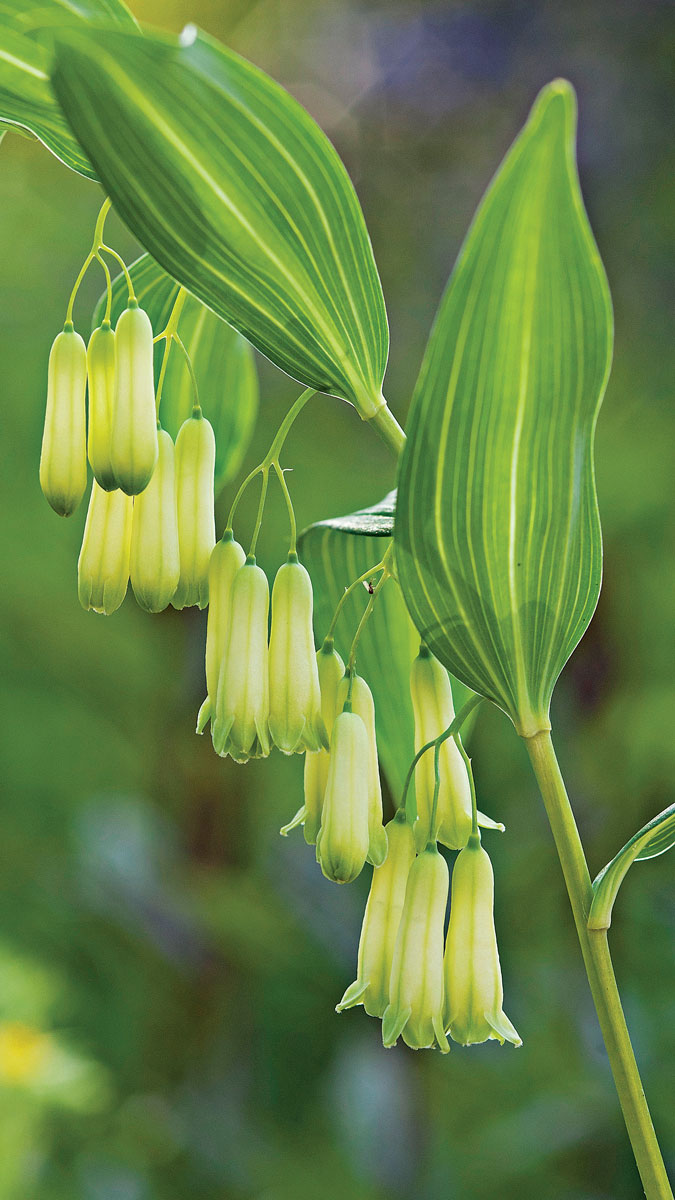
‘Silver Striped’ Solomon’s seal is subtle but still showy
Name: Polygonatum falcatum ‘Silver Striped’
Zones: 4–9
Size: 18 to 24 inches tall and wide
Conditions: Partial to full shade; average to moist soil
Native range: Japan
I am a huge fan of Solomon’s seal for its durability and good-looking foliage from spring to fall. Within the genus, ‘Silver Striped’ is a favorite for its distinct variegation in which a broad silver stripe highlights the center of each leaf. This band of silver is especially pronounced in spring and then fades as summer progresses. Compared to other plants in this article, ‘Silver Striped’ is subtle in terms of the silver in its foliage, but that is not necessarily a disadvantage. Its quiet nature allows you to layer the garden with some plants that are proudly silver. In my own garden I have it underplanted with Japanese painted fern and cannot get enough of the combination. Several variations of silver-centered Solomon’s seal are on the market, going by the names ‘Silver Striped’, ‘Silver Lining’, and ‘Silver Stripe’. Some sources list these as the same plant, but in my experience there are differences. Several years ago, Plant Delights Nursery offered ‘Silver Lining’ as a seed strain, noting that there was variation between each plant sold. In my own garden I grow ‘Silver Lining’ and ‘Silver Striped’, and while they both have the distinct silver banding on each leaf, they have very different overall forms. This is not the easiest plant to locate, so when you find it, grab it.

‘Venus’ heuchera won’t let you down
Name: Heuchera ‘Venus’
Zones: 4–9
Size: 9 to 12 inches tall and 12 to 18 inches wide
Conditions: Partial shade; moist, well-drained soil
Native range: Garden hybrid
I have a love/hate relationship with heucheras. Every year I am seduced by the latest dramatic foliage colors and textures, only to be frustrated when they never reach their billed potential in my garden and inevitably decline. I have found a few exceptions to this, and ‘Venus’ is one such plant. The muted silver-green leaves with dark green veins form a delightfully full yet compact mound. I have had ‘Venus’ in my garden for a number of years, where it is nestled near ‘Hennie Graafland’ astilbe (Astilbe ‘Hennie Graafland’, Zones 4–8). The shiny dark green astilbe foliage and sprays of pink flowers play nicely with the silver heuchera foliage, and the combination gets better each year. Two other heucheras worth mentioning are the durable ‘Frosted Violet’, featuring purple foliage with silver highlights and dark veins, and ‘Stainless Steel’, with bright silvery leaves that fade to a greenish silver as the season progresses. Most heucheras do best in light shade with a bit of direct sun.
Frank Fitzgerald is a landscape architect and plant expert from Minneapolis.
Sources
- Bluestone Perennials, Madison, OH; 800-852-5243; bluestoneperennials.com
- Plant Delights Nursery, Raleigh, NC; 919-772-4794; plantdelights.com
- Song Sparrow Farm and Nursery, Avalon, WI; 608-883-2356; songsparrow.com
- White Flower Farm, Litchfield, CT; 800-503-9624; whiteflowerfarm.com

















Comments
Thanks for sharing this article. I am glad to see this amazing post. https://minecraft-classic.com/
Minecraft Classic
Wordscapes Daily Puzzles
Log in or create an account to post a comment.
Sign up Log in